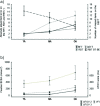Sensorimotor and cognitive factors associated with the age-related increase of visual field dependence: a cross-sectional study
- PMID: 26122710
- PMCID: PMC4485658
- DOI: 10.1007/s11357-015-9805-x
Sensorimotor and cognitive factors associated with the age-related increase of visual field dependence: a cross-sectional study
Abstract
Reliance on the visual frame of reference for spatial orientation (or visual field dependence) has been reported to increase with age. This has implications on old adults' daily living tasks as it affects stability, attention, and adaptation capacities. However, the nature and underlying mechanisms of this increase are not well defined. We investigated sensorimotor and cognitive factors possibly associated with increased visual field dependence in old age, by considering functions that are both known to degrade with age and important for spatial orientation and sensorimotor control: reliance on the (somatosensory-based) egocentric frame of reference, visual fixation stability, and attentional processing of complex visual scenes (useful field of view, UFOV). Twenty young, 18 middle-aged, and 20 old adults completed a visual examination, three tests of visual field dependence (RFT, RDT, and GEFT), a test of egocentric dependence (subjective vertical estimation with the body erect and tilted at 70°), a visual fixation task, and a test of visual attentional processing (UFOV®). Increased visual field dependence with age was associated with reduced egocentric dependence, visual fixation stability, and visual attentional processing. In addition, visual fixation instability and reduced UFOV were correlated. Results of middle-aged adults fell between those of the young and old, revealing the progressive nature of the age effects we evaluated. We discuss results in terms of reference frame selection with respect to ageing as well as visual and non-visual information processing. Inter-individual differences amongst old adults are highlighted and discussed with respect to the functionality of increased visual field dependence.
Figures




References
-
- Amblard B, Crémieux J, Marchand AR, Carblanc A. Lateral orientation and stabilization of human stance: static versus dynamic visual cues. Exp Brain Res. 1985;61:21–37. - PubMed
-
- Ambrose AF, Paul G, Hausdorff JM. Risk factors for falls among older adults: a review of the literature. Maturitas. 2013;75:51–61. - PubMed
-
- Anastasopoulos D, Bronstein A, Haslwanter T, Fetter M, Dichgans J. The role of somatosensory input for the perception of verticality. Ann N Y Acad Sci. 1999;871:379–383. - PubMed
-
- Assaiante C, Amblard B. Peripheral vision and age-related differences in dynamic balance. Hum Mov Sci. 1992;11:533–548.
Publication types
MeSH terms
LinkOut - more resources
Full Text Sources
Other Literature Sources
Research Materials
